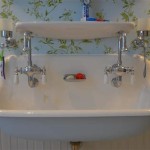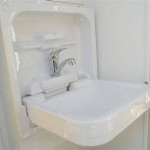Tiny Sinks for Bathrooms in Taiwan
Taiwan, known for its dense population and innovative use of space, has seen a surge in popularity for tiny sinks, particularly in bathrooms. These compact fixtures offer a practical solution for maximizing limited square footage without compromising functionality. This article will explore the driving factors behind this trend, the types of tiny sinks available, their advantages and disadvantages, installation considerations, and relevant regulations in Taiwan.
The increasing urbanization and rising property prices in Taiwanese cities have led to smaller living spaces, particularly apartments. Bathrooms, often the smallest room in the house, are prime candidates for space-saving solutions. Tiny sinks, also known as mini basins or compact sinks, offer a way to reclaim valuable floor area and create a more functional layout.
Several types of tiny sinks are available on the Taiwanese market, catering to diverse needs and aesthetic preferences. Wall-mounted sinks are a popular choice, projecting minimally into the bathroom space. Corner sinks effectively utilize otherwise wasted space. Pedestal sinks, while taking up more floor area than wall-mounted options, provide a classic and elegant aesthetic. Under-counter sinks, typically integrated into a vanity unit, offer storage space while maintaining a compact footprint.
Materials used in the construction of tiny sinks vary. Ceramic remains a common and affordable choice, offering durability and ease of cleaning. Glass sinks provide a sleek and modern look, while stone options, such as granite or marble, add a touch of luxury. Stainless steel sinks are durable and hygienic, making them a suitable choice for contemporary bathrooms.
The primary advantage of tiny sinks is their space-saving nature, allowing for more efficient use of limited bathroom space. This is particularly beneficial in Taiwanese apartments, where maximizing every square centimeter is crucial. They can also be more cost-effective than larger sinks due to requiring fewer materials in their production. Furthermore, the smaller surface area can make cleaning quicker and easier.
However, tiny sinks also have their limitations. The reduced basin size can make splashing more likely, potentially leading to water on the floor and surrounding surfaces. The limited counter space around the sink can also be inconvenient for storing toiletries and other bathroom essentials. Some users may find the smaller basin size less comfortable for everyday tasks such as washing their face or brushing their teeth.
Installing a tiny sink requires careful planning and consideration of the existing plumbing infrastructure. Wall-mounted sinks, in particular, may require reinforcement of the wall to support the weight of the basin. It's essential to ensure adequate water pressure and drainage to prevent issues such as slow draining or overflow. Compliance with local building codes and regulations is paramount.
In Taiwan, building codes regulate the installation of plumbing fixtures, including sinks. These regulations address aspects such as minimum basin size, water pressure requirements, and drainage system specifications. Homeowners and contractors should consult the relevant local authorities and obtain necessary permits before undertaking any plumbing work.
Choosing the right tiny sink involves considering factors such as available space, budget, aesthetic preferences, and functionality requirements. Measuring the available space accurately is crucial to ensure the chosen sink fits comfortably. Considering the overall bathroom design and style will ensure a cohesive aesthetic.
Maintenance of tiny sinks is generally straightforward. Regular cleaning with mild detergent and a soft cloth will prevent the buildup of soap scum and hard water stains. Avoid using abrasive cleaners that could scratch the surface of the basin. Periodically checking the plumbing connections for leaks and ensuring proper drainage will help maintain the sink's functionality.
The popularity of tiny sinks in Taiwan reflects a broader trend towards space-saving solutions in urban living. As living spaces become increasingly compact, optimizing space utilization becomes paramount. Tiny sinks, with their compact size and versatile designs, offer a practical and stylish solution for maximizing bathroom functionality in limited spaces, making them an increasingly common feature in Taiwanese homes.
The market for tiny sinks in Taiwan is constantly evolving, with manufacturers introducing new designs and materials to cater to the growing demand. Technological advancements are also playing a role, with features such as touchless faucets and integrated sensors becoming increasingly common. These innovations further enhance the functionality and convenience of tiny sinks, solidifying their place in the modern Taiwanese bathroom.

Tiny Vessel Sink Round Cast Concrete Wash Bowl In Teracotta

24 White Wall Mount Modern Small Floating Bathroom Sink

Bathroom Sinks Duravit

51 Bathroom Sinks That Are Overflowing With Stylistic Charm

The Seven Challenges Of Taiwanese Bathrooms Wanders World

Bathroom Sinks Duravit

54 Pedestal Sinks To Streamline Your Bathroom Design

54 Pedestal Sinks To Streamline Your Bathroom Design

Washbasins Duravit

Maileg Miniature Bathroom Sink Toypark
Related Posts







